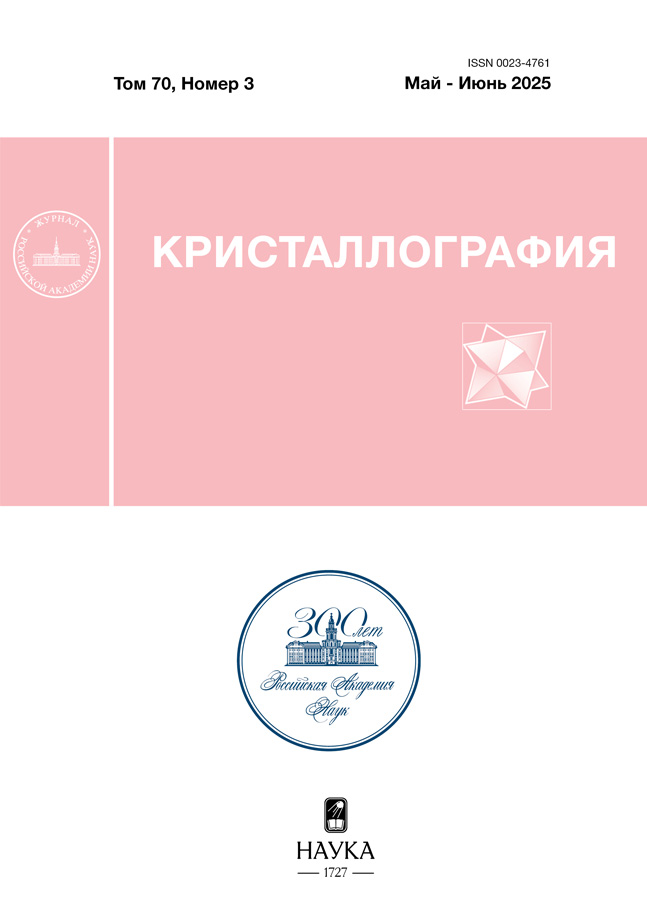A new type of copper-oxide cluster in the crystal structure of NaCu12(Si2O7)4Cl, a new representative of the alkali copper disilicate family
- Authors: Kornyakov I.V.1,2, Krivovichev S.V.1,2
-
Affiliations:
- Kola Science Centre, Russian Academy of Sciences
- St. Petersburg State University
- Issue: Vol 70, No 3 (2025)
- Pages: 428-433
- Section: СТРУКТУРА НЕОРГАНИЧЕСКИХ СОЕДИНЕНИЙ
- URL: https://rjonco.com/0023-4761/article/view/684966
- DOI: https://doi.org/10.31857/S0023476125030095
- EDN: https://elibrary.ru/BDIVKR
- ID: 684966
Cite item
Abstract
A new compound NaCu12(Si2O7)4Cl was synthesized by chemical deposition from gases. Using X-ray diffraction analysis, its crystal structure was established as containing 0-dimensional copper-oxide clusters Cu12O24 of a new type, which can be described as a truncated tetragonal bipyramid built from CuO4 square groups connected by sharing common edges and vertices. The complexes are combined through the Si2O7 disilicate groups into a three-dimensional electroneutral framework [[Cu12(Si2O7)4]0, built on the principle of the bcc grid (body-centered cubic lattice). In the cavities of the framework disordered Na+ and Cl– ions are located. The structure of the 12-nucleated copper-oxide clusters is similar to those of the CunO2n polyoxocuprates found in various minerals and inorganic compounds.
Full Text
About the authors
I. V. Kornyakov
Kola Science Centre, Russian Academy of Sciences; St. Petersburg State University
Email: s.krivovichev@ksc.ru
Nanomaterials Research Centre, Kola Science Centre, Russian Academy of Sciences; Institute of Earth Sciences, St. Petersburg State University
Russian Federation, Apatity; St. PetersburgS. V. Krivovichev
Kola Science Centre, Russian Academy of Sciences; St. Petersburg State University
Author for correspondence.
Email: s.krivovichev@ksc.ru
Nanomaterials Research Centre, Kola Science Centre, Russian Academy of Sciences; Institute of Earth Sciences, St. Petersburg State University
Russian Federation, Apatity; St. PetersburgReferences
- Shores M.P., Nytko E.A., Bartlett B.M. et al. // J. Am. Chem. Soc. 2005. V. 127. P. 13462. https://doi.org/10.1021/ja053891p
- Janson O., Tsirlin A.A., Schmitt M. et al. // Phys. Rev. B. 2010. V. 82. P. 014424. https://doi.org/10.1103/PhysRevB.82.014424
- Botana A.S., Zheng H., Lapidus S.H. et al. // Phys. Rev. B. 2018. V. 98. P. 054421. https://doi.org/10.1103/PhysRevB.98.054421
- Luo M., Li Z.-M., Qui J.-J. et al. // Res. Chem. Intermed. 2014. V. 40. P. 2895. https://doi.org/10.1007/s11164-013-1136-x
- Smurova L.A., Sorokina O.N., Kovarskii A.L. // Pet. Chem. 2017. V. 57. P. 1115. https://doi.org/10.1134/S0965544117100152
- Elakkiya V., Agarwal Y., Sumathi S. // Solid State Sci. 2018. V. 82. P. 92. https://doi.org/10.1016/j.solidstatesciences.2018.06.008
- Deng Z., Wang Z., Zhang P. et al. // Enzyme Microb. Technol. 2019. V. 126. P. 62. https://doi.org/10.1016/j.enzmictec.2019.03.007
- Wang P., Yuan Y., Xu K. et al. // Bioact. Mater. 2021. V. 6. P. 916. https://doi.org/10.1016/j.bioactmat.2020.09.017
- Корняков И.В. Синтез и кристаллохимия новых минералоподобных соединений двухвалентной меди. Дис. … канд. геол.-минерал. наук. СПб.: СПбГУ, 2021.
- Kornyakov I.V., Shilovskikh V.V., Bocharov V.N. et al. // Inorg. Chem. Commun. 2023. V. 157. P. 111435. https://doi.org/10.1016/j.inoche.2023.111435
- Rigaku Oxford Diffraction, CrysAlisPro Software System, version 42.102a. Rigaku Oxford Diffraction, Yarnton, England, 2023.
- Sheldrick G.M. // Acta Cryst. A. 2015. V. 71. P. 3. https://doi.org/10.1107/S2053273314026370
- Sheldrick G.M. // Acta Cryst. C. 2015. V. 71. P. 3. https://doi.org/10.1107/S2053229614024218
- Dolomanov O.V., Bourhis L.J., Gildea R.J. et al. // J. Appl. Cryst. 2009. V. 42. P. 339. https://doi.org/10.1107/S0021889808042726
- Gagné O.C., Hawthorne F.C. // Acta Cryst. B. 2015. V. 71. P. 562. https://doi.org/10.1107/S2052520615016297
- Brese N.E., O’Keeffe M. // Acta Cryst. B. 1991. V. 47. P. 192. https://doi.org/10.1107/S0108768190011041
- The Cambridge Crystallographic Data Centre (CCDC). Inorganic Crystal Structure Data Base – ICSD. https://www.ccdc.cam.ac.uk/, http://www.fizkarlsruhe.de
- Pennington W.T. // J. Appl. Cryst. 1999. V. 32. P. 1028. https://doi.org/10.1107/S0021889899011486
- Blatov V.A., Shevchenko A.P., Proserpio D.M. // Cryst. Growth Des. 2014. V. 14. P. 3576. https://doi.org/10.1021/cg500498k
- Krivovichev S.V., Filatov S.K., Vergasova L.P. // Miner. Petrol. 2012. V. 107. P. 235. https://doi.org/10.1007/s00710-012-0238-2.
- Krivovichev S.V. // CrystEngComm. 2024. V. 26. P. 1245.
- Shuvalov R.R., Vergasova L.P., Semenova T.F. et al. // Am. Mineral. 2013. V. 98. P. 463.
- Möller A. // Z. Anorg. Allg. Chem. 1998. V. 624. P. 1085. https://doi.org/10.1002/(SICI)1521-3749(199807)624:7<1085::AID-ZAAC1085>3.0.CO;2-J
- Möller A. // Z. Anorg. Allg. Chem. 1997. 1997. V. 623. P. 1685. https://doi.org/10.1002/zaac.19976231102
- Kawamura K., Kawahara A., Iiyama J.T. // Acta Cryst. B. 1978. V. 34. P. 3181. https://doi.org/10.1107/S0567740878010444
- dos Santos A.M., Brandão P., Fitch A. et al. // J. Solid State Chem. 2007. V. 180. P. 16. https://doi.org/10.1016/j.jssc.2006.09.012
- Krivovichev S.V. // Mineral. Mag. 2013. V. 77. P. 275. https://doi.org/10.1180/minmag.2013.077.3.05
- Krivovichev S.V., Krivovichev V.G. // Acta Cryst. A. 2020. V. 76. P. 429. https://doi.org/10.1107/S2053273320004209
- Kondinski A., Monakhov K.Y. // Chem. Eur. J. 2017. V. 23. P. 7841. https://doi.org/10.1002/chem.201605876
- Krivovichev S.V. // Acta Cryst. B. 2020. V. 76. P. 618.
- Effenberger H., Giester G., Krause W. et al. // Am. Mineral. 1998. V. 83. P. 607.
- Hawthorne F.C., Groat L.A. // Mineral. Mag. 1986. V. 50. P. 157.
- Cooper M.A., Hawthorne F.C. // Can. Mineral. 2000. V. 38. P. 801.
- Giuseppetti G., Mazzi F., Tadini C. // N. Jb. Miner. Mh. 1992. B. 1992. S. 113.
Supplementary files













